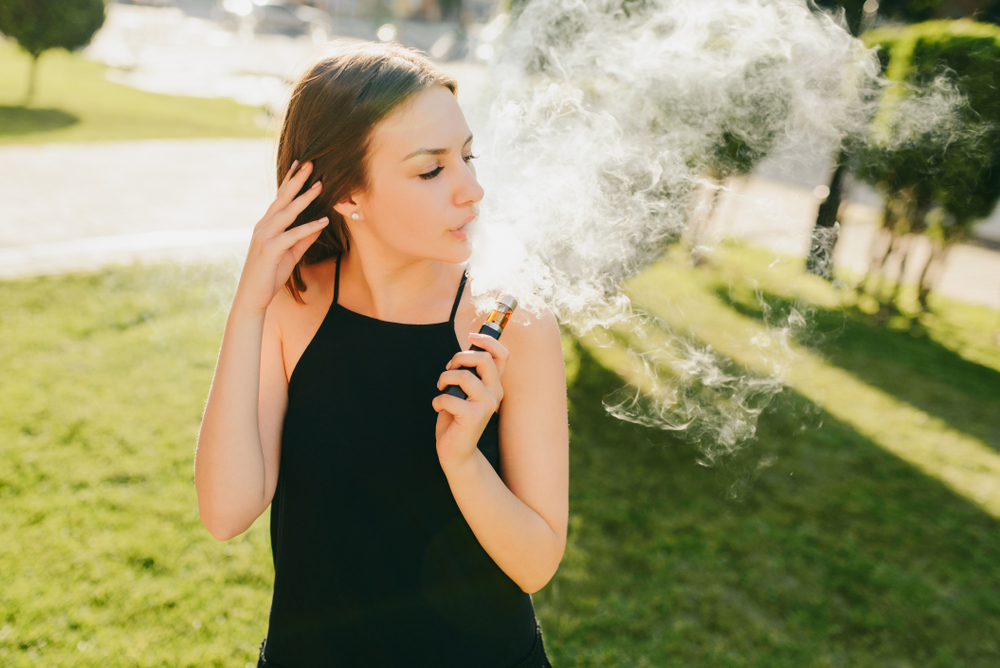By CRISTINA JANNEY
Hays Post
As the school year nears a close, administrators at Hays High School and Hays Middle School both said they have seen a spike this year in vaping referrals at the schools.
Neither HMS Principal Tom Albers nor HHS Assistant Principal John Linn had exact number of referrals they have received as a result of vaping, but both agreed the number of students using nicotine products at school has increased.
The 2017 Kansas Youth Risk Factors Survey shows one in three (or 34.8 percent) Kansas high school students have tried e-cigarettes and one in 10 (or 10.6 percent) were current users.
In light of the jump the Kansas State Board of Education will receive a presentation on vaping during its regular May meeting on Tuesday.
HHS is seeing very few referrals for traditional tobacco products, such as cigarettes or chewing tobacco, Linn said.

Easy to conceal
Linn said the most common devices he finds students using are Juuls, which is specific brand of vape device. The Juuls tend to be small, easy to conceal and sometimes resemble flash drives.
“I will be honest with you. I didn’t even know Juuls existed until the last couple of years,” he said, “and these things have just blown up.”
Albers said the vaping devices are easier for students to conceal than traditional tobacco.
“The one thing about cigarettes is that you can’t really do that without people seeing and smelling,” he said. … “Vape ends up being something that is easy to hide. It doesn’t produce smoke. It just produces a vape. It is really hard to see or find.”
Education lacking
Both administrators said despite information sent out to district patrons earlier this year about vaping as well as education in health classes, many students and parents are still not aware of the dangers of vaping.
“When I talk to our kids, it is more about trying to fit in,” Linn said. “I get very little about ‘I am trying to quit smoking so this is the best alternative to do that.’ You try to tell them no its not because it has the same amount of nicotine in those substances as a pack of cigarettes.”
Linn said he didn’t think students think about the addictive nature of nicotine when they vape.
“I think they think it is a safer alternative than smoking,” he said. “There has been multiple times this year that I have talked to students about vaping and these issues and asked them specifically, ‘Do you even know what you are sucking into your lungs? Do you even know what it is?’ You would be amazed about how many of them tell me no. They don’t know what it is. It just tastes good.”
Albers said companies are marketing to kids with sweet flavors. They also manipulate the amount of nicotine in vape pods. One pod can have the same amount of nicotine as three and half packs of cigarettes.
“Kids become addicted whether they realize it or not,” he said.
Most parents Linn said he has talked to are aware their children have tried vaping, but may not be aware they have a vaping device and are vaping on a regular basis.
“Again it comes back to education and letting them know it is the same issue as any type of tobacco product,”‘ Linn said. “It has nicotine, and that’s addictive. It is not good for students of this age whose brains are developing like they should.”
Health dangers of vaping
Dr. Michelle Pope, Hays pediatrician, spoke to TMP students last spring about the dangers of vaping.
Not only is the nicotine you can consume through vaping dangerous, but so are other chemicals and heavy metals you take into your lungs when you vape, she said.
Vaping liquids are loosely regulated by the federal government and 95 percent of the juices are made in China.
Vaping in teens can permanently stunt lung development. Nicotine, specifically, can cause cancer, is addictive and damaging, especially to the adolescent brain. It can also cause heart attack and stroke, Pope said.
School nicotine policy includes vaping
The Hays USD 489 school board passed revisions to its tobacco policy at its April 29 meeting. Superintendent John Thissen said the changes clarify what nicotine products are banned at the school.
This includes “any device that can be used to deliver nicotine or nicotine salts to the person inhaling from the device. Such definition shall include, but may not be limited to, any electronic cigarette, cigar, cigarillo, pipe or personal vaporizer.”
Vaping is banned not only in schools during school hours, but in any district facility; in school vehicles; at school-sponsored activities, programs, or events; and on school owned or operated property. The policy is the same for both school employees and students.
The consequences of vaping at school
For students, the policy goes on to discuss the consequences for students caught with nicotine or tobacco products.
According to the policy, “Student violations may result in parent/guardian notification, participating in tobacco education program, suspension and/or expulsion from school and/or extracurricular activities, community service, and/or notification of law enforcement.”
Linn said standard discipline at HHS for students caught with vaping devices or tobacco products is an automatic two-day in-school suspension. If the student is younger than 18, the police are contacted. If students are caught subsequent times, the disciplinary action can be heightened, Linn said.
“This is really frustrating, because the devices have changed so much. They are so difficult to detect,”Linn said. “I can search bags and all that kind of stuff, but if they hide it on themselves, it is very difficult to find sometimes. The companies have made it really easy for the students to use them and hide it.
“We do take it very seriously, and hopefully, we can get some kids to think before they do something like that.”
